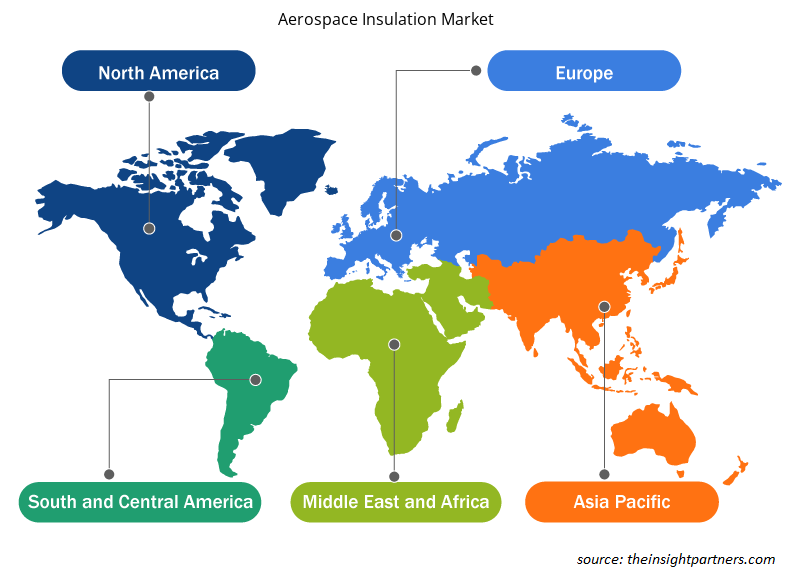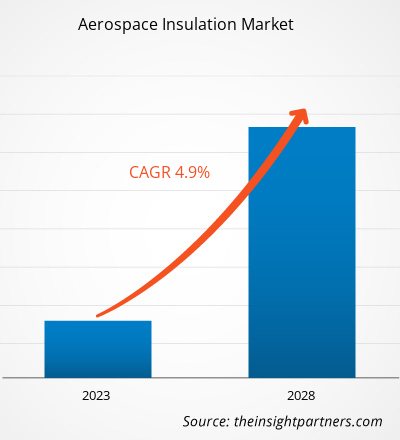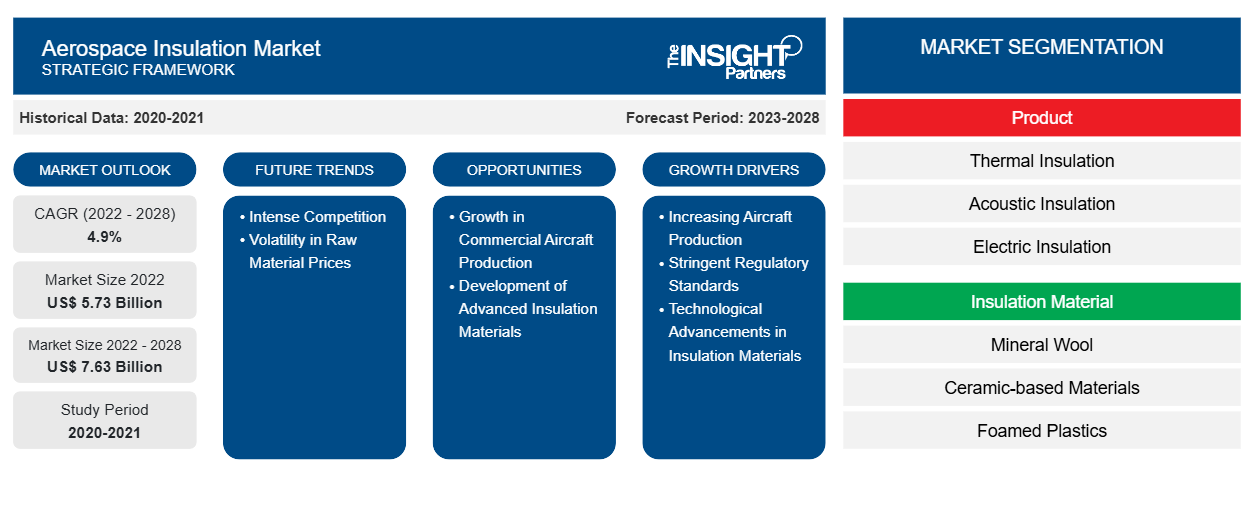Le marché de l'isolation aérospatiale devrait passer de 5 731,28 millions USD en 2022 à 7 633,23 millions USD en 2028 ; il devrait croître à un TCAC de 4,9 % de 2022 à 2028.
L'isolation aérospatiale fait référence au matériau installé dans l'avion pour améliorer les niveaux de sécurité et de confort. Les fonctions de l'avion dans des conditions climatiques difficiles doivent respecter certaines opérations fondamentales ainsi que des mesures de sécurité concernant à la fois le poids et la température et les performances globales. En raison des avantages, tels que des niveaux de vibrations et de bruit plus faibles pendant les heures de vol, la demande de matériaux isolants augmente à un rythme rapide. L'utilisation croissante de composites dans les avions commerciaux devrait stimuler le développement de diverses aérostructures, ce qui se traduira par un potentiel industriel substantiel. La demande croissante de matériaux isolants légers et de matériaux composites dans les industries des avions commerciaux et des jets d'affaires pour réduire le bruit en cabine devrait stimuler le marché au cours des prochaines années.
L'isolation aérospatiale joue un rôle crucial dans la protection de l'équipage et des passagers contre le bruit des générateurs et les températures glaciales à haute altitude. La demande croissante de flottes légères, de nouvelle génération et d'avions économes en carburant, ainsi que l'importance croissante de la réduction des émissions, devraient entraîner une augmentation de la production d'avions. Le développement significatif de l'industrie du voyage dans les marchés émergents et le nombre croissant de passagers pour les voyages internationaux et nationaux sont les principaux facteurs qui stimulent le marché mondial de l'isolation aérospatiale . Par exemple, selon l'Association du transport aérien international (IATA), la demande totale de voyages aériens en avril 2022 a augmenté de 78,7 % par rapport à avril 2021.
Personnalisez ce rapport en fonction de vos besoins
Vous bénéficierez d'une personnalisation gratuite de n'importe quel rapport, y compris de certaines parties de ce rapport, d'une analyse au niveau des pays, d'un pack de données Excel, ainsi que de superbes offres et réductions pour les start-ups et les universités.
- Obtenez les principales tendances clés du marché de ce rapport.Cet échantillon GRATUIT comprendra une analyse de données, allant des tendances du marché aux estimations et prévisions.
Selon la Federal Aviation Administration (FAA), tous les avions commerciaux doivent être dotés d'une isolation thermique et acoustique. Ces isolants permettent de garantir que le confort des passagers ne soit pas affecté par les variations de température extérieure et que le bruit excessif généré par l'avion ne perturbe pas la communication. Ces réglementations strictes incitent les constructeurs aéronautiques à utiliser des matériaux isolants dans les avions, ce qui stimule le marché de l'isolation aéronautique.
De nombreux fabricants d'isolants aéronautiques, tels que Zotefoams, développent des matériaux de construction aéronautiques légers pour accroître l'efficacité énergétique et la durabilité. L'isolation thermique et acoustique protège contre les bruits et les températures excessives dans la plupart des avions. L'isolation thermique et acoustique est une fibre haute performance unique enfermée dans un revêtement en plastique de qualité aéronautique qui maintient les matériaux isolants ensemble tout en fonctionnant également comme une barrière contre l'humidité.
Informations sur le marché
La croissance du secteur du transport aérien stimule le marché de l'isolation aérospatiale
Le secteur du transport aérien connaît une croissance rapide et devrait continuer sur cette lancée au cours des prochaines années. Selon les estimations de l'Association internationale du transport aérien (IATA), la demande de transport aérien devrait augmenter en moyenne de 4,3 % par an jusqu'en 2036. Si cette croissance est atteinte d'ici 2036, l'industrie du transport aérien devrait contribuer à 15,5 millions d'emplois directs et à 1,5 billion de dollars du PIB à l'économie mondiale au cours de la période de prévision. Une croissance aussi importante de la demande de transport aérien entraînera une augmentation de la demande d'avions. L'isolation aérospatiale est utilisée dans les avions pour augmenter le confort et la sécurité de l'avion et des passagers, ce qui devrait propulser le marché de l'isolation aérospatiale au cours de la période de prévision. De plus, le coût des matériaux composites est en baisse constante, ce qui permet aux constructeurs aéronautiques d'utiliser des composites pour l'isolation aérospatiale. Par conséquent, en raison de ces facteurs, le marché prospérera rapidement au cours de la période de prévision.
Informations sur les produits
En fonction du produit, le marché de l'isolation aérospatiale est segmenté en isolation thermique, isolation acoustique, isolation électrique et isolation antivibratoire. En 2021, le segment de l'isolation thermique a dominé le marché et devrait croître à un TCAC plus rapide au cours de la période de prévision. L'augmentation des activités de recherche et développement pour produire des matériaux d'isolation thermique avancés, légers et durables, stimule la croissance du segment de l'isolation thermique au cours de la période de prévision.
3M ; TransDigm Group Incorporated ; Triumph Group, Inc. ; Johns Manville ; Morgan Advanced Materials Plc ; Polymer Technologies Inc. ; Duracote Corporation ; Rogers Corporation ; DuPont ; et BASF SE sont les principaux acteurs du marché de l'isolation aérospatiale. Les principaux acteurs adoptent plusieurs stratégies, telles que les fusions et acquisitions et les lancements de produits, pour étendre leur présence géographique et leur clientèle.
Aperçu régional du marché de l'isolation aérospatiale
Les tendances et facteurs régionaux influençant le marché de l’isolation aérospatiale tout au long de la période de prévision ont été expliqués en détail par les analystes d’Insight Partners. Cette section traite également des segments et de la géographie du marché de l’isolation aérospatiale en Amérique du Nord, en Europe, en Asie-Pacifique, au Moyen-Orient et en Afrique, ainsi qu’en Amérique du Sud et en Amérique centrale.

- Obtenez les données régionales spécifiques au marché de l'isolation aérospatiale
Portée du rapport sur le marché de l'isolation aérospatiale
| Attribut de rapport | Détails |
|---|---|
| Taille du marché en 2022 | 5,73 milliards de dollars américains |
| Taille du marché d'ici 2028 | 7,63 milliards de dollars américains |
| Taux de croissance annuel composé mondial (2022-2028) | 4,9% |
| Données historiques | 2020-2021 |
| Période de prévision | 2023-2028 |
| Segments couverts | Par produit
|
| Régions et pays couverts | Amérique du Nord
|
| Leaders du marché et profils d'entreprises clés |
|
Densité des acteurs du marché de l'isolation aérospatiale : comprendre son impact sur la dynamique commerciale
Le marché de l'isolation aérospatiale connaît une croissance rapide, tirée par la demande croissante des utilisateurs finaux en raison de facteurs tels que l'évolution des préférences des consommateurs, les avancées technologiques et une plus grande sensibilisation aux avantages du produit. À mesure que la demande augmente, les entreprises élargissent leurs offres, innovent pour répondre aux besoins des consommateurs et capitalisent sur les tendances émergentes, ce qui alimente davantage la croissance du marché.
La densité des acteurs du marché fait référence à la répartition des entreprises ou des sociétés opérant sur un marché ou un secteur particulier. Elle indique le nombre de concurrents (acteurs du marché) présents sur un marché donné par rapport à sa taille ou à sa valeur marchande totale.
Les principales entreprises opérant sur le marché de l'isolation aérospatiale sont :
- Société Duracote
- Société Rogers
- DuPont
- BASF SE
- 3M
Avis de non-responsabilité : les sociétés répertoriées ci-dessus ne sont pas classées dans un ordre particulier.

- Obtenez un aperçu des principaux acteurs du marché de l'isolation aérospatiale
Rapports en vedette
- Tendances progressistes dans le secteur de l'isolation aérospatiale pour aider les acteurs à développer des stratégies efficaces à long terme
- Stratégies de croissance commerciale adoptées par les entreprises pour assurer leur croissance sur les marchés développés et en développement
- Analyse quantitative du marché mondial de l'isolation aérospatiale de 2021 à 2028
- Estimation de la demande d'isolation aérospatiale dans diverses industries
- Analyse des cinq forces de Porter pour illustrer l'efficacité des acheteurs et des fournisseurs opérant dans le secteur de l'isolation aérospatiale
- Développements récents pour comprendre le scénario concurrentiel du marché et la demande d'isolation aérospatiale
- Tendances et perspectives du marché associées aux facteurs régissant la croissance du marché de l'isolation aérospatiale
- Comprendre les stratégies qui sous-tendent l'intérêt commercial par rapport à la croissance du marché, en aidant au processus de prise de décision
- Taille du marché de l'isolation aérospatiale à différents nœuds du marché
- Aperçu détaillé et segmentation du marché ainsi que de sa dynamique sectorielle
- Taille du marché de l'isolation aérospatiale dans diverses régions avec des opportunités de croissance prometteuses
L'analyse du marché de l'isolation aérospatiale jusqu'en 2028 est une étude spécialisée et approfondie de l'industrie des produits chimiques et des matériaux, axée sur l'analyse des tendances du marché. Le rapport vise à fournir un aperçu du marché avec une segmentation détaillée. Le marché de l'isolation aérospatiale est segmenté en fonction du produit, du matériau isolant, de l'avion et de la géographie. En fonction du produit, le marché est segmenté en isolation thermique, isolation acoustique, isolation électrique et isolation antivibratoire. En fonction du matériau isolant, le marché est segmenté en laine minérale, matériaux à base de céramique, plastiques expansés, fibre de verre et autres. En fonction des avions, le marché est segmenté en moteur et cellule. En fonction de la géographie, le marché est segmenté en cinq régions principales : l'Amérique du Nord, l'Europe, l'Asie-Pacifique, le Moyen-Orient et l'Afrique, et l'Amérique du Sud et l'Amérique centrale. En 2021, l'Amérique du Nord a dominé le marché. Cependant, l'Asie-Pacifique devrait enregistrer le TCAC le plus élevé du marché au cours de la période de prévision.
- Analyse historique (2 ans), année de base, prévision (7 ans) avec TCAC
- Analyse PEST et SWOT
- Taille du marché Valeur / Volume - Mondial, Régional, Pays
- Industrie et paysage concurrentiel
- Ensemble de données Excel
Rapports récents
Rapports connexes
Témoignages
Raison d'acheter
- Prise de décision éclairée
- Compréhension de la dynamique du marché
- Analyse concurrentielle
- Connaissances clients
- Prévisions de marché
- Atténuation des risques
- Planification stratégique
- Justification des investissements
- Identification des marchés émergents
- Amélioration des stratégies marketing
- Amélioration de l'efficacité opérationnelle
- Alignement sur les tendances réglementaires





















 Obtenez un échantillon gratuit pour - Marché de l'isolation aérospatiale
Obtenez un échantillon gratuit pour - Marché de l'isolation aérospatiale